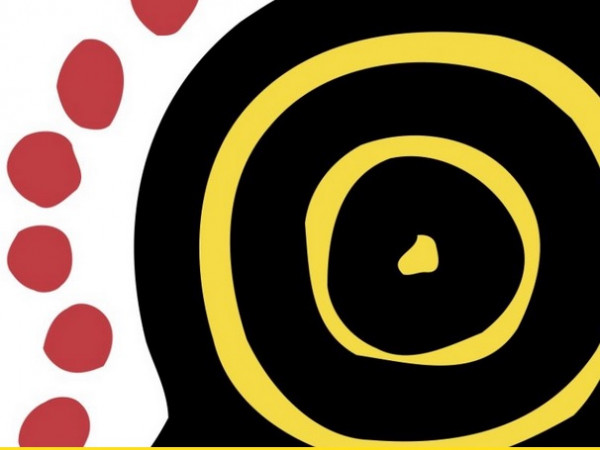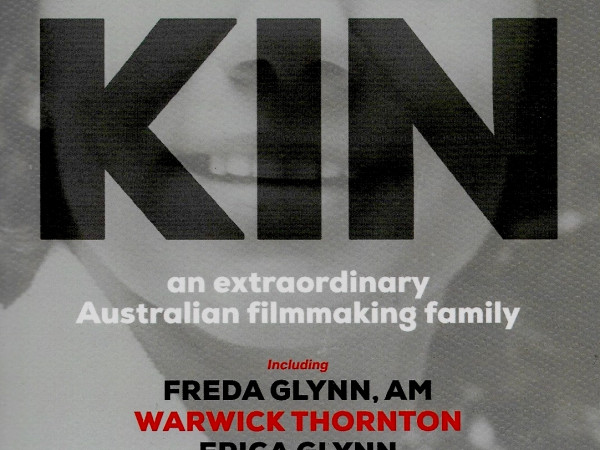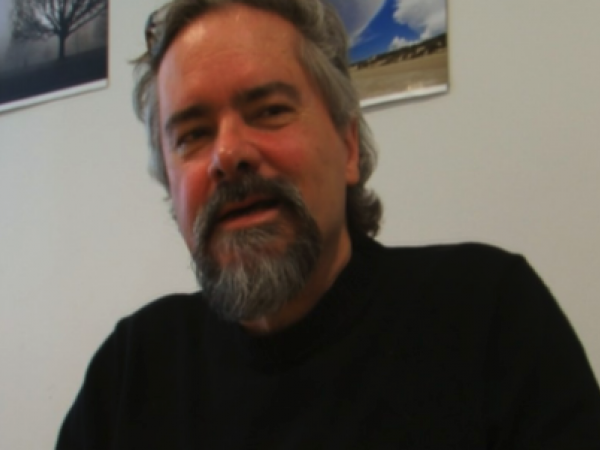Freda Glynn
‘We were going to make our mob proud of themselves…’
Freda Glynn:
Well, I don't know what the spark was. It was Johnny Macumba’s idea… his idea was to make weekly news cassettes to give to people around the camps in Aboriginal languages. And that's what we started off as. That's what we started doing.
[Freda radio commentating] I used to do the voiceover, right, and explain what was the next news will be read by so-and-so in Warlpiri language or in Arrente. I was just filling in, thinking I'm going to go and do something else later, you know? Go back to cleaning or something, that was just …I didn't ever think that I was going to be the Director…
[Freda as Director on archive film] For me, it was …the set up of a media organization, it was frowned upon, right?. We didn't need media because we needed health, housing, education. But at the beginning, to me, it was important for making another different kind of employment opportunities for Aboriginal people, as well as getting the news and information … in their own language, telling them what the government, what decisions they were making about… Being able to provide them with information to where you go to and what you needed, in say health …Creating community service announcements so that they could …you know if there’s whooping cough going, you could talk about that, if there was measles going on, you could talk about that.
Erica Glynn:
Vital information…
Freda Glynn:
…vital information in their own language, that was really what our first thinking was …Our first radio station was 8kin…people used to come in and out to record their things, that we had in four languages. [Freda on archive film: ‘Well, I don't know if you know, but we're going to air in three Aboriginal communities in Alice Springs right at this moment’, followed by Johnny Macumba] Johnny, didn't hang around that long, because he was always busy doing something, you know, I started out as sort of just with Philip [Batty] developing it, you know, and it was just …Philip and my role, it really was to find money, see what grants were going on and get money to get the place together. And Philip and I'd just got on and started finding money for different things. And it just grew and it grew and it grew.
Philip Batty:
[Introduces himself on archive film]…By ’81, in one year, this organisation has gone from pretty much nothing much, bit of an idea, through to a point where we were sitting in the ABC, no we were sitting in a …CAAMA was sitting in its own studios on Gap Road. It was producing programmes for three outlets, for the ABC, for 8HA the commercial station and 8CCC, the public section. At that point there was no organisation in Australia that was producing radio programming from the commercial end through to the community.
Freda Glynn:
And that's when we started recording too. We were really struggling to get music because we didn't have anything.
Philip Batty:
Yeah, that's right. We got around to a lot of the town camps recording local artists. Some were fantastic singers.
Freda Glynn:
It was the music in the beginning that made 8kin really popular every …you know, people say that those taxis have got 8kin on, somebody else would say ‘…I was at a tyre place the other day and they had 8kin on’, and somebody said ‘Oh yeah, I know so and so, they wouldn't go without listening to 8kin, you know’, and it was, it was very popular, really popular.
[TV Commentary] ‘Unfortunately, Alice Springs has a name for drunken aboriginals in the street. They're on public display and it's not a pretty sight.’
Erica Glynn:
So besides radio, our mob, we're not seeing themselves represented on screen either, that unless it was a story about them, not for them
Freda Glynn:
Yeah, you know, long lenses…fights in the creek and all that sort of stuff. That's right.
Erica Glynn:
So obviously, then you decided that the next step, you set up the video unit…
Freda Glynn:
[Freda on archive film introducing CAAMA’s new video cassette]
Erica Glynn:
And right at that time, news in the country, Aboriginal stuff was being bloody ignored. People were feeling shit, they were hiding stuff and CAAMA put value on anything black.
Freda Glynn:
That was part of what was in our heads…at the beginning, Johnny Macumba said, Phillip and I: ‘Aboriginal culture is …dance, singing, storytelling’, and that's what I wanted CAAMA to continue in the radio station and in the production - so Aboriginal people could see themselves on television, could see themselves as vital for …Australia for keeping that all strong, not being ashamed of it: it just needed this little bit of pride.
And we were going to look after our mob. We were going to make our mob proud of themselves, you know, and it was for us, it wasn't for the whole country. And that's what it was all about.
Erica Glynn:
And then CAAMA’s Video Productions really took off, eh?
Freda Glynn:
Oh, God, absolutely. And that's where all you kids got the bug. You, Rachel, David, Tricia, Warwick, Jason, you’re all still working in the industry now.
Philip Batty:
And we also hooked in with AFTRS, Australian Film and Television School – that, in my view, there was probably one of the greatest achievements of CAAMA because it provided the seedbed for what we see today - you know, thriving Aboriginal film and television sector, you know, with people employed, probably hundreds of people employed in that area now.
Freda Glynn [on archive film]:
Most communities around the centre don't have access to Radio. One community of a thousand people just outside of Alice Springs, about 300 kilometres away, has one radio telephone. And now video’s become very, very popular in these communities, but they still don't have access to any other communications
Commentary [on archive film]:
But the federal government's planned purchase of the AUSSAT satellite, which will bring radio and television broadcasting to outback Australia, has added a new dimension to CAAMA’s future.
Philip Batty:
Ever since CAAMA was established, we've been talking about getting access to the satellite…not running a commercial TV station or anything like it. We just wanted to get access to the satellite service to extend the Radio, the Radio Broadcasting Service right across Central Australia if not beyond that. And also, to start providing television programming to that…very large Aboriginal audience in that footprint: it was about 30, 40 percent. It's important to understand too that we're up against Packer, the most powerful media man in the country.
Commentary [on archive film]:
Until very recently, Freda Glynn was best known as the director of CAAMA and one of its principle driving forces. She's also the chairperson of Imparja.
Freda Glynn:
To be able to bid for the AUSSAT satellite licence, we had to create a TV Company called Imparja. And that’s when I really learned how to fight…
Commentary [on archive film]:
For many people in the outback AUSSAT will be a blessing. And while the Aborigines can see the advantages, they're concerned that white man's television could destroy the black man's culture.
Freda Glynn [on archive film]:
Well, it's very important simply because if you’re, if you were an Aboriginal child sitting there watching American television, Australian television, that has no relevance to you, and the only time you see your people as when they’re jumping up and down in demonstrations or riots, then it'll give Aboriginal kids a false impression of their worth in the society.
Commentary [on archive film]:
The Aborigines see this as one way of countering the negative effects of the satellite.
Freda Glynn [on archive film]:
If we're allowed to control it, if we have some kind of input into what's going to be fed into the Aboriginal communities, then we can use it as a tool for change. But do… using it for training and schooling and informing Aboriginal people in their own language what else is happening in Australia and in the community.
Commentary [on archive film]:
When the announcement was made by the Broadcasting Tribunal, Chief Minister Steve Hatton and his deputy Ray Hanrahan were quick to attack the decision because non-Aborigines would be forced to watch Aboriginal television.
Interviewer [on archive film]:
…the Northern Territory government say that Imparja will promote racial conflict. What do you say to that?
Freda Glynn [on archive film]:
Well, I could be flippant and say, ah, well, we've got good teachers, but I'd probably say that this is probably bring more harmony to the Territory simply because I think that there's lots of people out there interested in what Aboriginal people are doing, and what our issues are….
Freda Glynn [on archive film]:
We're now going to live by the satellite - throughout Northern Territory and South Australia.
Philip Batty:
And in the end, we swung it, we got the license.
Freda Glynn: Yeah, I remember that… jubilation and… …
Philip Batty:
…the jubilation, and it was great, national news and that it was a major, major victory. And then I woke up in the morning….
Freda Glynn:
…and we had to go ahead and get them…
Philip Batty:
Yeah, well, that was when the hard work…That was when the really hard work came on…
Freda Glynn:
We had two programmes on the Imparja licence. We had Urrpeye and Nganampa Anwernekenhe. One was a magazine programme. The other one was storytelling from the Bush in Aboriginal languages. People would sit for hours and do dreaming stories …just in the shade of a tree. And that's where the whole thing, the whole series would be listening to this old man telling a story. What did they used to call it? They called it the Nganampa pan – a slow pan across the country while they're telling the stories.
Erica Glynn:
Is it true to say that Imparja turned out to be a bit of a poisoned chalice for you both?
Freda Glynn:
Oh, absolutely. At the end of the day we couldn't sell advertising around the Aboriginal programmes. It was as simple as that.
Philip Batty:
Yeah, I think this problem that we've been handed by the minister originally, of having to operate a commercial television service on the one hand, but to provide programming to Aboriginal people that didn't really earn any money. So that was that conflict at the heart of the station and ultimately the Aboriginal Board took the view ‘No, it's got to be just commercial. Well, so yeah, there was an absolute fundamental clash at the heart of the, heart of Imparja Television…
Freda Glynn:
I just couldn't work with the Board after that, you know. The Board had decided that Philip and I were no longer relevant to what was happening in the organization, so they asked us to finish up. So we did. I walked out the day that I got the information.
Erica Glynn:
Were you hurt?
Freda Glynn:
Of course, I was hurt, and I just don't want to keep on talking about CAAMA all the time. It was wonderful at the time while I was doing it. And that's over now. And it's my life we're talking about. It was only a little time…My grandchildren [say]: ‘Nana you must be so proud of what you did’. I'm proud of the kids I brought up, and I'm proud of the grandkids I got … and I'm also proud of CAAMA, but I don't know. I really don't know. I don't dwell on CAAMA. I don't dwell on that. It's there and it's growing, and it grew and it's…because of what CAAMA did, it's all out in every community. All that's because other people have worked, you know. Seeing Aboriginal faces on television must have made other Aboriginal people around Australia say ‘Oh, I want to do this, I want to, you know, I can make a difference. I can say things now. We can argue back. We've got somewhere to go now’, and it's happened, it's happening all over. Nowadays, I just want to sit here, each day and be here by myself, I just want to zone out and hope that good thoughts going up to wherever it goes and good things happen in the world – I’m a bit ideal…. What's the word? - idealistic. I just, just want good things for people. And hope it happens to everybody. And people don't get left behind. Enough?
Erica Glynn: I do think we’re done Mum
Freda Glynn: Oh, lovely…
Erica Glynn: You want to carry on talking now, don’t you?
Freda Glynn: No…




